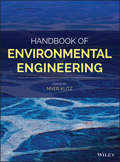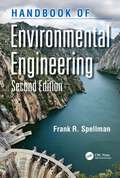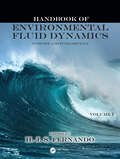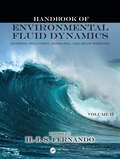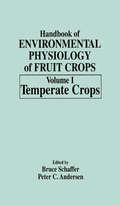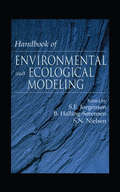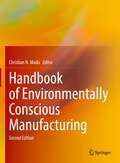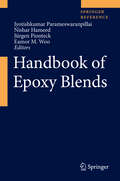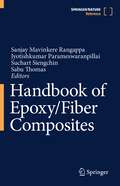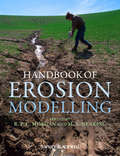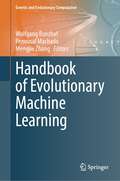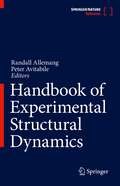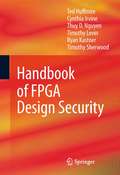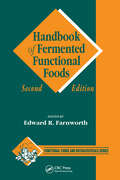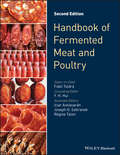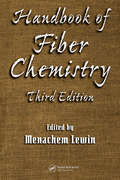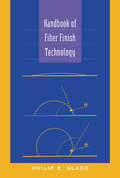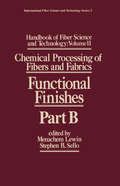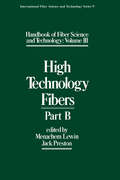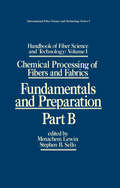- Table View
- List View
Handbook of Environmental Contaminants: A Guide for Site Assessment
by Chris ShineldeckerHandbook of Environmental Contaminants: A Guide for Site Assessment is an indispensable working reference for environmental assessment professionals faced with determining potential environmental contaminants that might be found in the soil, groundwater, or air of a property or facility. The book provides a comprehensive listing of potential contaminants associated with hundreds of industries, activities, and processes. The types of properties covered range from agricultural to heavy industrial. The products and processes covered range from the processing of yeast to the constituents of rocket fuel. The book also discusses products associated with the degradation of common chemical solvents in the environment.Handbook of Environmental Contaminants: A Guide for Site Assessment is an important reference for environmental consultants, workers on Superfund sites, public health and safety professionals, attorneys, educators and students, and lenders.
Handbook of Environmental Control: Cumulative Series Index for Volumes I-V (Crc Handbook Of Environmental Control Ser. #Vol. 1)
by Richard G BondThis volume which carries the designationCumulative Series Index, is the master key to the first five volumes of the CRC Handbook of Environmental Control. It represents a reasonable effective solution of an inherent problem in the reference information field.
Handbook of Environmental Engineering
by Myer KutzA comprehensive guide for both fundamentals and real-world applications of environmental engineering Written by noted experts, Handbook of Environmental Engineering offers a comprehensive guide to environmental engineers who desire to contribute to mitigating problems, such as flooding, caused by extreme weather events, protecting populations in coastal areas threatened by rising sea levels, reducing illnesses caused by polluted air, soil, and water from improperly regulated industrial and transportation activities, promoting the safety of the food supply. Contributors not only cover such timely environmental topics related to soils, water, and air, minimizing pollution created by industrial plants and processes, and managing wastewater, hazardous, solid, and other industrial wastes, but also treat such vital topics as porous pavement design, aerosol measurements, noise pollution control, and industrial waste auditing. This important handbook: Enables environmental engineers to treat problems in systematic ways Discusses climate issues in ways useful for environmental engineers Covers up-to-date measurement techniques important in environmental engineering Reviews current developments in environmental law for environmental engineers Includes information on water quality and wastewater engineering Informs environmental engineers about methods of dealing with industrial and municipal waste, including hazardous waste Designed for use by practitioners, students, and researchers, Handbook of Environmental Engineering contains the most recent information to enable a clear understanding of major environmental issues.
Handbook of Environmental Engineering (Applied Ecology And Environmental Management Ser. #9)
by Frank R. SpellmanThis new edition provides a practical view of pollution and its impact on the natural environment. Driven by the hope of a sustainable future, it stresses the importance of environmental law and resource sustainability and offers a wealth of information based on real-world observations and expert experience. It presents a basic overview of environmental pollution, emphasizes key terms, and addresses specific concepts in advanced algebra, fundamental engineering, and statistics. In addition, it considers socioeconomic, political, and cultural influences and provides an understanding of how to effectively treat and prevent air pollution, implement industrial hygiene principles, and manage solid waste, water, and wastewater operations. The Handbook of Environmental Engineering is written in a down-to-earth style for a wide audience, as it appeals to technical readers, consultants, policymakers, as well as a wide range of general readers. Features: Updated throughout, with a new chapter on modern trends in environmental engineering, the book further emphasizes climate change effects on water/wastewater infrastructure Examines the physical, chemical, and biological processes fundamental to understanding the environment fate and engineered treatment of environmental contaminants Presents technologies to prevent pollution at the source as well as treatment and disposal methods for remediation Identifies multiple environmental pollutants and explains the effects of each Includes the latest environmental regulatory requirements.
Handbook of Environmental Fluid Dynamics, Volume One: Overview and Fundamentals
by H. J. S. FernandoWith major implications for applied physics, engineering, and the natural and social sciences, the rapidly growing area of environmental fluid dynamics focuses on the interactions of human activities, environment, and fluid motion. A landmark for the field, the two-volume Handbook of Environmental Fluid Dynamics presents the basic principles, funda
Handbook of Environmental Fluid Dynamics, Volume Two: Systems, Pollution, Modeling, and Measurements
by H. J. S. FernandoWith major implications for applied physics, engineering, and the natural and social sciences, the rapidly growing area of environmental fluid dynamics focuses on the interactions of human activities, environment, and fluid motion. A landmark for the field, the two-volume Handbook of Environmental Fluid Dynamics presents the basic principles, funda
Handbook of Environmental Health, Volume I: Biological, Chemical, and Physical Agents of Environmentally Related Disease
by Michael S. Bisesi Herman KorenThe Handbook of Environmental Health-Biological, Chemical and Physical Agents of Environmentally Related Disease, Volume 1, Fourth Edition includes twelve chapters on a variety of topics basically following a standard chapter outline where applicable with the exception of chapters 1, 2 and 12. The outline is as follows:1. Background and status2. Sc
Handbook of Environmental Health, Volume II: Pollutant Interactions in Air, Water, and Soil
by Herman Koren Michael S. BisesiThe Handbook of Environmental Health-Pollutant Interactions in Air, Water, and Soil includes Nine Chapters on a variety of topics basically following a standard chapter outline where applicable with the exception of Chapters 8 and 9. The outline is as follows:1. Background and status2. Scientific, technological and general information3. Statement o
Handbook of Environmental Physiology of Fruit Crops
by Bruce Schaffer Peter C. AndersenThese exciting new companion handbooks are the only ones of their kind devoted solely to the effects of environmental variables on the physiology of the world's major fruit and nut crops. Their cosmopolitan scope includes chapters on tropical and temperate zone species written by scientists from several continents. The influence of environmental factors, such as irradiance, temperature, water and salinity on plant physiology and on vegetative and reproductive growth, is comprehensively discussed for each crop. In addition to being a thorough and up-to-date set of textbooks, the organzation of the two volumes makes them an excellent reference tool. Each chapter focuses on a single crop, or a group of genetically or horticulturally related crop, and is appropriately divided into subsections that address individual environmental factors. Some chapters emphasize whole-plant physiology and plant growth and development, while other chapters feature theoretical aspects of plant physiology. Several chapters provide botanical background discussions to enhance understanding of the crop's response to its environment.
Handbook of Environmental and Ecological Modeling (Environmental & Ecological (Math) Modeling #1)
by Sven E. JorgensenWith descriptions of hundreds of the most important environmental and ecological models, this handbook is a unique and practical reference source. The Handbook of Environmental and Ecological Modeling is ideal for those working in environmental modeling, including regulators and managers who wish to understand the models used to make assessments. Overviews of more than 360 models are easily accessed in this handbook, allowing readers to quickly locate information they need about models available in a given ecosystem.The material in the Handbook of Environmental and Ecological Modeling is logically arranged according to ecosystem. Each of the sixteen chapters of the handbook covers a particular ecosystem, and includes not only the descriptions of the models, but also an overview of the state-of-the-art in modeling for that particular ecosystem. A summary of the spectrum of available models is also provided in each chapter. The extensive table of contents and the easy-to-use index put materials immediately at your fingertips.
Handbook of Environmentally Conscious Manufacturing
by Christian N. MaduManufacturers, under pressure from their major stakeholders, integrate environmental issues in the design and management of their products. These stakeholders include customers, regulators, employees, communities, and interest groups who have a common stake in protecting the earth from pollution and in limiting the exploitation of earth's limited natural resources. Manufacturers recognize that being environmentally responsible also offers competitive advantage to the firm. The Handbook of Environmentally Conscious Manufacturing is written as a state-of-the-art reference to guide environmentally conscious manufacturing (ECM). All the contributors have done extensive research and/or practice work in the field of ECM. The Handbook covers all the major topics in Environmentally Conscious Manufacturing. There are specific chapters to deal with sustainable manufacturing, recycling, eco-labelling, life cycle assessment, and ISO 14000 series of standards, as well as decision-making aspects of Environmentally Conscious Manufacturing. Decision-oriented topics on supply chain, decision models, quality initiative, environmental costing and decision support systems are also covered. The influence of ECM on marketing imperative is also covered.
Handbook of Epoxy Blends
by Jyotishkumar Parameswaranpillai Nishar Hameed Jürgen Pionteck Eamor M. WooThis reference work compiles and summarizes the available information on epoxy blends. It covers all essential areas - the synthesis, processing, characterization and applications of epoxy blends - in a comprehensive manner. The handbook is highly application-oriented and thus serves as a valuable, authoritative reference guide for researchers, engineers, and technologists working on epoxy blends, but also for graduate and postgraduate students, polymer chemists, and faculties at universities and colleges. The handbook is divided into three parts and organized by the types of blends and components: Part I covers epoxy rubber blends, Part II focuses on epoxy thermoplastic blends, and Part III examines epoxy block-copolymer blends. Each part starts with an introduction, and the individual chapters provide readers with comprehensive information on the synthesis and processing, analysis and characterization, properties and applications of the different epoxy blends. All parts conclude with a critical evaluation of the applications, weighing their advantages and drawbacks. Leading international experts from corporate and academic research institutions and universities discuss the correlations of different epoxy blend properties with their macro-, micro- and nanostructures. This handbook thus offers a rich resource for newcomers to the field, and a major reference work for experienced researchers, the first of its kind available on the market. As epoxies find extremely broad applications, e. g. in oil & gas, in the chemical industry, building and construction industry, automotive, aviation and aerospace, boat building and marine applications, in adhesives and coatings, and many more, this handbook addresses researchers and practitioners from all these fields.
Handbook of Epoxy/Fiber Composites
by Sabu Thomas Jyotishkumar Parameswaranpillai Suchart Siengchin Sanjay Mavinkere RangappaThis handbook presents the current state-of-knowledge in the area of epoxy fiber composites. The book emphasizes new challenges and covers synthesis, characterization, and applications of epoxy/fiber composites. Leading researchers from industry, academy, government and private research institutions across the globe have contributed to this book. The contents comprehensively cover the current status, trends, future directions, and application opportunities in the field. This highly application-oriented handbook will be of use to researchers and professionals alike.
Handbook of Erosion Modelling
by R.P.C. Morgan M. A. NearingThe movement of sediment and associated pollutants over the landscape and into water bodies is of increasing concern with respect to pollution control, prevention of muddy floods and environmental protection. In addition, the loss of soil on site has implications for declining agricultural productivity, loss of biodiversity and decreased amenity and landscape value. The fate of sediment and the conservation of soil are important issues for land managers and decision-makers. In developing appropriate policies and solutions, managers and researchers are making greater use of erosion models to characterise the processes of erosion and their interaction with the landscape. A study of erosion requires one to think in terms of microseconds to understand the mechanics of impact of a single raindrop on a soil surface, while landscapes form over periods of thousands of years. These processes operate on scales of millimetres for single raindrops to mega-metres for continents. Erosion modelling thus covers quite a lot of ground. This book introduces the conceptual and mathematical frameworks used to formulate models of soil erosion and uses case studies to show how models are applied to a variety of purposes at a range of spatial and temporal scales. The aim is to provide land managers and others with the tools required to select a model appropriate to the type and scale of erosion problem, to show what users can expect in terms of accuracy of model predictions and to provide an appreciation of both the advantages and limitations of models. Problems covered include those arising from agriculture, the construction industry, pollution and climatic change and range in scale from farms to small and large catchments. The book will also be useful to students and research scientists as an up-to-date review of the state-of-art of erosion modelling and, through a knowledge of how models are used in practice, in highlighting the gaps in knowledge that need to be filled in order to develop even better models.
Handbook of Essential Oils: Science, Technology, and Applications
by K. Hüsnü Can Başer and Gerhard BuchbauerHandbook of Essential Oils: Science, Technology, and Applications presents the development, use and marketing of essential oils. Exciting new topics include insecticidal applications, but there is a continued focus on the chemistry, pharmacology and biological activities of essential oils. The third edition unveils new chapters including the insect repellent and insecticidal activities of essential oils, the synergistic activity with antibiotics against resistant microorganisms, essential oil applications in agriculture, plant-insect interactions, and pheromones and contaminants in essential oils. Features Presents a wide range of topics including sources, production, analysis, storage, transport, chemistry, aromatherapy, pharmacology, toxicology, metabolism, technology, biotransformation, application, utilization, and trade Includes discussions of biological activity testing, results of antimicrobial and antioxidant tests, and penetration enhancing activities useful in drug delivery Covers up-to-date regulations and legislative procedures, together with the use of essential oils in perfumes, cosmetics, feed, food, beverages, and pharmaceutical industries Unveils new chapters including the insect repellent and insecticidal activities of essential oils, the synergistic activity with antibiotics against resistant microorganisms, essential oil applications in agriculture, plant-insect interactions, and pheromones and contaminants in essential oils The American Botanical Council (ABC) named the second edition as the recipient of the 2016 ABC James A. Duke Excellence in Botanical Literature Award and recognized that essential oils are one of the fastest growing segments of the herbal product market
Handbook of Evolutionary Machine Learning (Genetic and Evolutionary Computation)
by Penousal Machado Mengjie Zhang Wolfgang BanzhafThis book, written by leading international researchers of evolutionary approaches to machine learning, explores various ways evolution can address machine learning problems and improve current methods of machine learning. Topics in this book are organized into five parts. The first part introduces some fundamental concepts and overviews of evolutionary approaches to the three different classes of learning employed in machine learning. The second addresses the use of evolutionary computation as a machine learning technique describing methodologic improvements for evolutionary clustering, classification, regression, and ensemble learning. The third part explores the connection between evolution and neural networks, in particular the connection to deep learning, generative and adversarial models as well as the exciting potential of evolution with large language models. The fourth part focuses on the use of evolutionary computation for supporting machine learning methods. This includes methodological developments for evolutionary data preparation, model parametrization, design, and validation. The final part covers several chapters on applications in medicine, robotics, science, finance, and other disciplines. Readers find reviews of application areas and can discover large-scale, real-world applications of evolutionary machine learning to a variety of problem domains. This book will serve as an essential reference for researchers, postgraduate students, practitioners in industry and all those interested in evolutionary approaches to machine learning.
Handbook of Experimental Structural Dynamics
by Randall Allemang Peter AvitabileThe SEM Handbook of Experimental Structural Dynamics stands as a comprehensive overview and reference for its subject, applicable to workers in research, product design and manufacture, and practice. The Handbook is devoted primarily to the areas of structural mechanics served by the Society for Experimental Mechanics IMAC community, such as modal analysis, rotating machinery, structural health monitoring, shock and vibration, sensors and instrumentation, aeroelasticity, ground testing, finite element techniques, model updating, sensitivity analysis, verification and validation, experimental dynamics sub-structuring, quantification of margin and uncertainty, and testing of civil infrastructure. Chapters offer comprehensive, detailed coverage of decades of scientific and technologic advance and all demonstrate an experimental perspective. Several sections specifically discuss the various types of experimental testing and common practices utilized in the automotive, aerospace, and civil structures industries. · History of Experimental Structural Mechanics · DIC Methods - Dynamic Photogrammetry · LDV Methods · Applied Digital Signal Processing · Introduction to Spectral - Basic Measurements · Structural Measurements - FRF · Random and Shock Testing · Rotating System Analysis Methods · Sensors Signal Conditioning Instrumentation · Design of Modal Tests · Experimental Modal Methods · Experimental Modal Parameter Evaluation · Operating Modal Analysis Methods · Analytical Numerical Substructuring · Finite Element Model Correlation · Model Updating · Damping of Materials and Structures · Model Calibration and Validation in Structures · Uncertainty Quantification: UQ, QMU and Statistics · Nonlinear System Analysis Methods (Experimental) · Structural Health Monitoring and Damage Detection · Experimental Substructure Modeling · Modal Modeling · Response (Impedance) Modeling · Nonlinear Normal Mode Analysis Techniques (Analytical) · Modal Modeling with Nonlinear Connection Elements (Analytical) · Acoustics of Structural Systems (VibroAcoustics) · Automotive Structural Testing · Civil Structural Testing · Aerospace Perspective for Modeling and Validation · Sports Equipment Testing · Applied Math for Exper
Handbook of FPGA Design Security
by Ryan Kastner Ted Huffmire Timothy Sherwood Thuy D. Nguyen Timothy Levin Cynthia IrvineThe purpose of Handbook of FPGA Design Security is to provide a practical approach to managing security in FPGA designs for researchers and practitioners in the electronic design automation (EDA) and FPGA communities, including corporations, industrial and government research labs, and academics. Handbook of FPGA Design Security combines theoretical underpinnings with a practical design approach and worked examples for combating real world threats. To address the spectrum of lifecycle and operational threats against FPGA systems, a holistic view of FPGA security is presented, from formal top level specification to low level policy enforcement mechanisms. This perspective integrates recent advances in the fields of computer security theory, languages, compilers, and hardware. The net effect is a diverse set of static and runtime techniques that, working in cooperation, facilitate the composition of robust, dependable, and trustworthy systems using commodity components.
Handbook of Fermented Functional Foods (Functional Foods and Nutraceuticals)
by Edward R. FarnworthFor centuries, people around the world have used fermentation to preserve and enhance the flavor of a wide variety of foods. Today, complex interactions of microbiota in the digestive tract are found to influence proper digestion, metabolism, and disease resistance. With greater emphasis on natural products and the role of food in health and wellbe
Handbook of Fermented Meat and Poultry
by Y. H. Hui Iciar Astiasaran Joseph Sebranek Regine Talon Fidel ToldrFermented meat products have been consumed for centuries in many different parts of the world and constitute one of the most important groups of food. Bacterial cultures are used in their manufacture to preserve the meat and confer particular textures and sensory attributes. Examples of fermented meats include salami, chorizo, pepperoni and saucisson.This fully revised and expanded reference book on meat fermentation presents all the principle fermented meat products and the processing technologies currently used in their manufacture. The 54 chapters of this substantial book are grouped into the following sections:* Meat fermentation worldwide: overview, production and principles* Raw materials* Microbiology and starter cultures for meat fermentation* Sensory attributes* Product categories: general considerations* Semidry-fermented sausages* Dry-fermented sausages* Other fermented meats and poultry* Ripened meat products* Biological and chemical safety of fermented meat products* Processing sanitation and quality assuranceThere are five new chapters in the second edition that address the following topics: Smoking and new smoke flavourings; Probiotics; Methodologies for the study of the microbial ecology in fermented sausages; Low sodium in meat products; and Asian sausages.Handbook of Fermented Meat and Poultry, Second Edition provides readers with a full overview of meat fermentation, the role of microorganisms naturally present and/or added as starter cultures, safety aspects and an account of the main chemical, biochemical, physical and microbiological changes that occur in processing and how they affect final quality. Finally, readers will find the main types of worldwide fermented meat products, typically produced in different areas, with the description of their main characteristics.
Handbook of Fiber Chemistry (International Fiber Science and Technology)
by Menachem LewinThe Handbook of Fiber Chemistry, Third Edition provides complete coverage of scientific and technological principles for all major natural and synthetic fibers. Incorporating new scientific techniques, instruments, characterization, and processing methods, the book features important technological advances from the past decade, particularly
Handbook of Fiber Finish Technology
by Philip E. SladeDiscusses the components of textile finishes, and the chemical and physical properties of, as well as their effects on, various fibres. The book covers fundamentals of fibre finish science, such as theories of friction; laboratory testing of formulations, from preliminary component evaluation to analyses for material characterization; and the influence of wetting, emulsification and finish distribution on coatings.
Handbook of Fiber Science and Technology Volume 2: Chemical Processing of Fibers and Fabrics-- Functional Finishes Part B
by Menachem Lewin and Stephen B. SelloContinuing the outstanding coverage from Part A, the authoritative information inFunctional Finishes, Part B makes your work with fibers and fabrics cost-effective ...offers practical guidance in finishing techniques-including flame retardancy, water andoil repellency, soil release, electroconductivity, and radiation ... and eases your continuingstudy of this expanding field with numerous, current references-with manyoriginal findings not previously cited.As new advances widen the scope of this field, each volume of Handbook of Fiber Scienceand Technology becomes an indispensable acquisition for researchers. Textile ,fiber, polymer, organic, physical, and biological chemists; textile finishers and chemicalmanufacturers; R & D personnel in the polymer, fiber, chemical, and textile industries;plastics and chemical engineers; materials scientists; and wood and paper technologistswill find them essential references. They are also superior sources of supplementaryreading for graduate and advanced undergraduate courses in polymer, fiber, and textilechemistry and technology ; chemical processing of fibers, chemical technology andengineering, and polymer processing.
Handbook of Fiber Science and Technology Volume 2: High Technology Fibers: Part B (International Fiber Science And Technology Ser. #9)
by Menachem Lewin Jack PrestonMaintaining the high standards set in Part A, this important reference brings you the mostcomprehensive, up-to-date coverage of both recently developed and potentially available fibersfor applications outside the textile industry.Emphasizing practical industrial applications and future research directions for high technologyfibers , Handbook of Fiber Science and Technology: Volume III, Part B sharesresearch developments in high-modulus fibers from organic polymers or inorganic materials... discusses how to predict applications for aramid fibers based upon structure/propertyrelationships .. . sets forth fundamental principles for spinning polymers to fibers . ..reviews the underlying science and technology of fibers derived from thennotropic copolyesters... and more.
Handbook of Fiber Science and Technology: Chemical Processing of Fibers and Fabrics - Fundamentals and Preparation Part B
by Menachem Lewin and Stephen B. SelloContinuing the outstanding coverage from Part A, the authoritative information inFundamentals and Preparation, Part B rounds out the first comprehensive treatise onchemical processing of textiles. A systematic, single-source treatment of key topics inthe field, this state-of-the-art work introduces major savings in time and cost to yourwork with fibers and fabrics .. . provides a foundation for projecting future developments. .. and guides you to useful further study with helpful, current references.As new advances expand the scope of this field , each volume of Handbook of FiberScience and Technology becomes an indispensable acquisition for researchers. Textile, fiber , polymer, organic, physical, and biological chemists; textile finishers andchemical manufacturers; research and development personnel in the polymer, fiber,chemical, and textile industries ; plastics and chemical engineers; materials scientists ;and wood and paper technologists will find them essential references. They are eminentsources for supplementary reading in graduate and advanced undergraduate coursesincluding polymer, fiber, and textile chemistry and technology; chemical processing offibers; chemical engineering ; and polymer processing.


